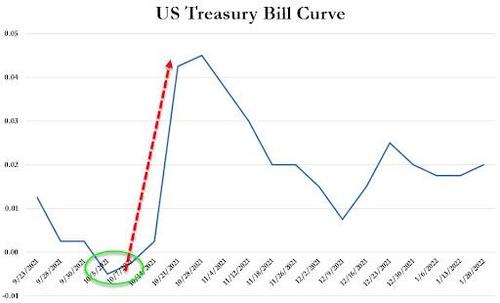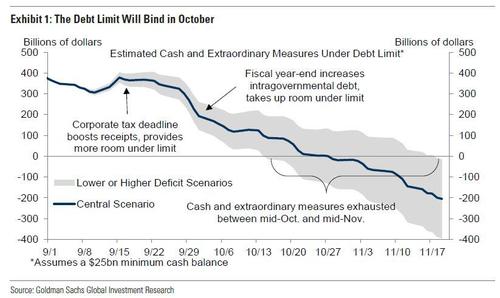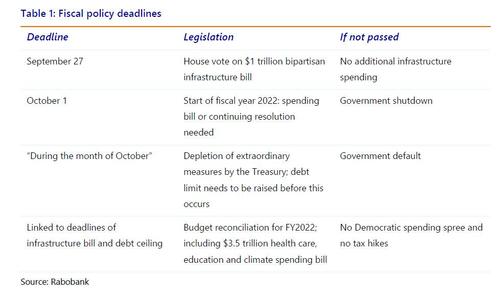Biden’s Debt Limit Game Of Chicken
By Philip Marey of Rabobank
Summary
- In October we could see both a government shutdown and a government default if the spending and debt bill approved by the House of Representatives yesterday does not pass the Senate.
- This is a game of chicken in which the Democrats try to force the Republicans to share the blame for suspending the debt limit in light of the midterm elections in 2022.
- This stand-off is completely unnecessary and if the Republicans don’t blink, the Democrats can still raise the debt limit and adopt a spending patch through budget reconciliation.
- However, this will raise the internal pressure in the Democratic Party regarding Biden’s legislative agenda by adding another time constraint.
Introduction: Pelosi is raising the stakes
Yesterday, the House of Representatives passed a bill that would fund the government through December 3, 2021, and suspend the debt limit through December 16, 2022. Note that this would remove the debt limit from the legislative agenda until after the midterm elections on November 8, 2022. There were 220 Democratic votes in favor of the bill, and 211 Republican votes against it. This bill is supported by the Democratic leadership, including President Biden. However, before he can sign this into law, the Senate has to vote on it. This is expected to happen later this week or early next week. On Monday, Senate Minority Leader McConnell said the Republicans will support a clean continuing resolution that includes disaster aid and refugee resettlement funding, but not legislation to raise the debt limit. If the spending and debt bill does not pass the Senate, we could see both a shutdown and a default of the US government in October, a probability that is growing by the day according to the T-Bill market.
Each October, the start of the new fiscal year requires either a spending bill1 or a continuing resolution (a spending patch that does not last the entire fiscal year). If such a measure is not adopted before October 1, the federal government will have to shut down, because the authority to spend money is lacking. The House bill would delay this until after December 3, giving Congress more time to come up with a full fiscal year spending bill. However, if the Senate does not pass it, the government will partially shut down on October 1.
Meanwhile, August 1 saw the return of the debt limit, which had been suspended in 2019. The Treasury is taking extraordinary measures to allow the federal government to keep fulfilling its obligations, but in a September 8 letter to House Speaker Pelosi, Treasury Secretary Yellen indicated that these measures will be depleted sometime “during the month of October.” If the debt limit is not raised before this occurs, the federal government will be in default.
The bipartisan route or via budget reconciliation?
The first observation we would like to make is that the possible standoff that could lead to a government shutdown and default is entirely unnecessary. The Democrats could have chosen to raise the debt limit through budget reconciliation. This would not require a single Republican vote. So keeping it out of budget reconciliation and asking the Republicans for support is a conscious decision by the Democratic leadership. The main reason is that raising the debt ceiling could hurt the Democrats in the midterm elections in 2022, so they prefer sharing the blame with the Republicans by forcing them to support a suspension of the debt limit. In other words, the Democrats have set up a game of chicken to get the Republicans’ fingerprints on the debt limit suspension. The Democrats are counting on business leaders to pressure the Republican Party into avoiding a government default. However, the Republican Party’s relationship with corporate America has suffered in recent years as the party has moved toward economic populism. Of course, Biden only needs 10 Republican votes. However, in August 46 Republican senators signed a letter that they would not raise the debt limit. Hence, at most 54 votes are available, which is not enough.
As long as this spending and debt bill is not approved, the government will partially shut down on October 1 and “during the month of October” the government will no longer be able to meet all its obligations, thus being in default. So Congress has about a week to prevent a government shutdown and at most 5 weeks to avert a government default.
If the Republicans don’t blink
The Republicans have said they won’t raise the debt limit, because the Democrats are trying to pass a $3.5 trillion package through budget reconciliation and passed the $1.9 trillion American Rescue Plan earlier this year without any Republican votes. However, President Biden is calling their bluff by attaching the debt limit suspension to a spending patch and a hurricane relief bill. This will make it more difficult for Republicans to explain to the voters that they are going to shoot this down in the Senate. If they do, the federal government will be heading for default in October.
However, if the Republicans don’t blink, the Democrats can still raise the debt limit and adopt a spending patch through budget reconciliation, without a single Republican vote. Of course, this implies an additional deadline on the $3.5 trillion health care, education and climate package. There is already a weaker deadline because Pelosi has promised to bring up the $1 trillion bipartisan infrastructure bill for a vote by September 27, which is also a time constraint on the $3.5 trillion package because progressives do not want to pass the infrastructure bill before the health care, education and climate bill. This is the second reason why the Democratic leadership has chosen this confrontational route to a game of chicken: it will give them more time for the $3.5 trillion deal.
In table 1 we have summarized the four deadlines that are coming together in just a few weeks.
The game
If the US government shuts down or even defaults, this is entirely a self-inflicted event. In fact, this can be seen as a three stage game. Pelosi has made the move in the first stage, by choosing to attach debt suspension to the spending patch. If she had put forward a clean CR, the Republicans in the Senate were willing to accept. However, now she is triggering a game of chicken (stage 2) where the Republicans will either stick to their promise not to raise the debt limit or blink.
If they blink, a government shutdown and default will be avoided. If they don’t, the Democrats will have to decide whether to shut down the government and risk a default or raise the debt limit through budget reconciliation (stage 3).
In the final stage of the game, the Democrats have the power to raise the debt ceiling and adopt a spending patch, through budget reconciliation, without any Republican vote. Therefore it will be difficult to blame a government shutdown or even a default on the Republicans. The mainstream media may try to do so anyway, but conservative media – which are relevant to Republican voters – will explain the realities to their audience. Therefore, there is no electoral need for the Republicans to blink. If they have the stomach for it, they can win this game and force the Democrats to “own” their spending spree. What’s more, if the Democrats fail to stick together under pressure, Biden’s ambitious legislative agenda could dissolve in October.
By forcing the debt limit legislation into the budget reconciliation process the Republicans will also increase the internal pressure in the Democratic Party regarding the Biden agenda, by adding another time constraint on the $3.5 trillion plan and the $1 trillion infrastructure bill. This is also an incentive for the Democrats to keep the debt limit out of budget reconciliation. From this perspective, we could draw the conclusion that the internal divisions in the Democratic Party are contributing to the choice of the Democratic leadership to play a game of chicken on the debt ceiling that could result in a government default. However, this plan could very well backfire and force the Democrats to raise the debt ceiling through budget reconciliation. The main challenge will then be to keep the Democratic Party together on the $3.5 trillion package, which could very well result in a substantial reduction of that number.
Conclusion
We could have called this special report “McConnell’s Game of Chicken.” After all, in August 46 Republican senators signed a letter that they would not raise the debt limit. However, the Democrats don’t need Republican support to adopt a spending patch and raise the debt limit: it can all be done through budget reconciliation. However, the Democrats made a conscious decision to take the bipartisan route, a route they usually shun. But they don’t want to be seen as the party that raised the debt limit and rather share the blame of suspending it, in light of the midterm elections in 2022. This appears particularly weird since the Democrats want to get a $3.5 trillion package through budget reconciliation, without the need of Republican votes. So the Democrats want to go on a spending spree, but they don’t want to be seen as the party that raises the credit card limit.
This is why we call it “Biden’s Game of Chicken.” At first sight it would appear that the Republicans are up to their old tricks again of sabotaging Democratic policies through the debt limit, jeopardizing the reputation of US government debt. However, this is not a repeat of the Tea Party obstruction of the Obama administration. This time the Democrats are intentionally looking for a confrontation they can easily avoid. In fact, McConnell has already indicated that he would support a clean CR, without a debt limit suspension attached to it. The Democrats won the elections, they want to spend trillions on Democratic priorities without Republican support, and they can raise the debt limit in the same process.
Tyler Durden
Wed, 09/22/2021 – 19:20![]()
Zero Hedge’s mission is to widen the scope of financial, economic and political information available to the professional investing public, to skeptically examine and, where necessary, attack the flaccid institution that financial journalism has become, to liberate oppressed knowledge, to provide analysis uninhibited by political constraint and to facilitate information’s unending quest for freedom. Visit https://www.zerohedge.com


